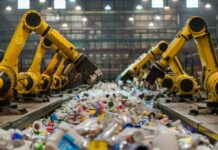Coca-Cola is a recognisable brand with a well-known taste and bottle. When The Coca-Cola Company wants to improve the way things are done, it targets not just its flagship beverage and all its varieties but also a broad range of fluids, sparkling drinks, hydration and sports drinks, dairy and plant-based beverages, juices, coffees, teas, etc.
Cloeann Durham, vice president of quality, safety, and environment for Coca-Cola’s North American Operating Unit, said that they have to take all of that into account when designing a sustainability plan. She was addressing the crowd at the ISBT BevTech conference in Frisco, Texas. Sustainability is equally vital, she said, even as Coca-Cola brands are poised for growth. It is nice to see volumes increase. However, if one observes volume growth without sustainability, it might outrun it very quickly, she added.
The sustainability priorities themselves also don’t come in short supply: assisting in the global packaging waste crisis, reducing emissions through scientific targets while trying to construct resilience for climatic changes now and in the future, enhancing water supply for processes, safeguarding societies and the environment, lowering added sugar from across the portfolio while giving consumers more choices and smaller packaging options, and developing a more sustainable supply chain.
Coca-Cola is working towards goals that include 2025 packaging objectives, a 2030 climate target, a new 2030 water plan, and a streamlined global beverage portfolio. The company has already achieved some of its ecological, social, and governance goals. Throughout it all, getting assistance from above has been essential. Durham refers to chairman and CEO, James Quincey, and says, they have the dedication at the top level of their company.
Consumer-friendly openness
According to Durham, Coca-Cola has been motivated to consistently improve by openness, which includes publicly disclosed sustainability goals and accountability for results. Over time, there have been significant changes in the beverage business. A motivational TV commercial is no longer sufficient to persuade customers. Regarding today’s demands, she states that data is basically all one has to voice opinions. Targeting that is based on science, provides a higher level of openness.
Durham focused more closely on a few areas, but Coca-Cola has a wide range of sustainable business aims. Its World Without Waste campaign, which focuses mostly on packaging and how to promote a circular economy to help lower the carbon emissions of that packaging, is a substantial effort.
The bottle’s design is the subject of one initiative’s component. By 2025, Coca-Cola wants all of its packaging to be recyclable, and by 2030, it wants to utilise at least 50% recyclable materials. Durham said that since not all tags are recyclable, the label plays a significant role in this debate. 90% of the company’s packaging is currently recyclable around the world, and it utilises 23% recycled materials. According to her, four markets employ 100% recycled PET for their complete plastic packaging portfolio, while about 30 markets provide at least one brand in packaging made entirely of recycled PET.
The corporation has also set a new reuse objective for its brand: by 2030, the company wants to sell at least 25% of its beverages by volume in refillable, returnable glass or plastic bottles, fountain dispensers with reusable packaging, or other such containers. This project’s recycling activities themselves are the subject of another section. Much of this depends on educating customers about recycling, which is difficult given how fluid the situation is in the U.S., where there are 50 different states. Within a distance of about five miles, Durham said, she travels from one place to the next, and the recycling efforts are noticeably different.
Coca-Cola wants to collect and recycle one bottle or can for every one it sells by the year 2030. 61% of the comparable cans or bottles that the business put on the market in 2021 have already been recycled, collected, or refilled.
Coca-Cola intends to cut total greenhouse gas (GHG) emissions by 25% by 2030. The company is very well aware of how climate change directly affects its operations all over the world. According to Durham, here is where science-based planning really shines, and there has been a significant change in how businesses currently discuss their climate targets. She remarked that they need to measure differently if they want to be truly effective. One really has to be able to access a big new metric with science-based targeting. It needs so much effort from each of the partners.
Keeping Water Resources Safe
Coca-Cola is making efforts to reduce both its water impact and its carbon footprint. For a business whose goods rely so heavily on water, this is a major concern. With a context-based approach to service replenishment, support for wise water policies, and responsible water usage throughout all operations and the supply chain, the 2030 Water Security Strategy seeks to increase water security.
The fact that 92% of Coca-Cola’s blue water use the surface and groundwater utilised as a result of generating the yield comes from within its agricultural value chain indicates just how important effective agricultural management is to this. In 2021, 58% of the volume of Coca-Cola’s priority ingredients were supplied sustainably as part of efforts to expand a more sustainable supply chain. 100% is the ultimate objective. Durham added that they need to make sure they are not having a negative impact on the system. They are working toward being 100%. She has a good feeling about that, but the discussions must continue.
The sector is struggling to overcome earlier complacency. They have had chances to innovate, but they haven’t since it hasn’t seemed necessary, she added. In order to avoid having a detrimental impact on sustainability, they must ensure that they anticipate these challenges. Together with its roughly 225 bottlers in more than 200 countries around the world, Coca-Cola is working on these initiatives. Though tackling such global concerns would seem daunting to many, Durham advised members of the audience to think differently, despite the fact that the beverage giant has extensive resources at its disposal for these sorts of sustainability projects. They are all driving the industry, she continued, so focus more on how people engage rather than the stats. How can we accomplish that as a team?




























